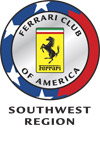
Volume 9 Issue 1 - January/February 2002
Published: January 1, 2002
FCA Goes to Go Kart Racing School
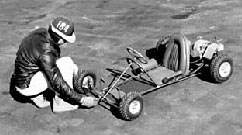
it was at an
american aviation base in 1951 that the first go-kart appeared. with some
tubes, wheels, and lawn-mower engines the teams on the ground tinkered the
first go-kart.
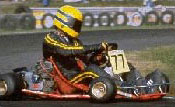
the go-kart
is a tremendous school to make pilots of high level, as prost, schumacher,
truli, verstappen, fisichella and so many others have proven. the late ayrton
senna was twice world champion of go-karting.
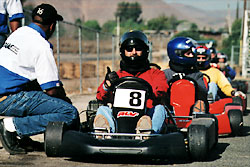
so on sunday,
november 18th we arrived at the adams go kart track in riverside, ca at 7:45
a.m. for what would be one of the most fun events organized by the club in a
long time. we had rented the track for half a day and all 29 of us were ready
to test our skills.
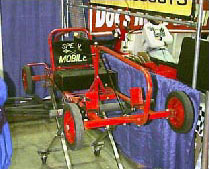
the adams
kart track has one of the longest straights in the country measuring an
impressive 700 feet, with 14 different turns that challenge even the most
veteran drivers. they say that "if you race well here, you race well
everywhere." this track hosts the annual california state championships and
has a large pit and control tower overlooking the whole area.
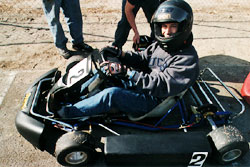
excitement
filled the cold morning air as the crew prepared the go karts. this is what
michael schumacher does when he is not driving his ferrari f1 car, and we were
about to experience it first-hand ourselves!
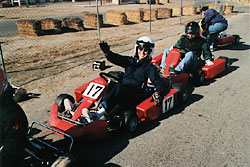
after a brief
drivers meeting, we were directed to the race track where two of the
instructors walked us around the track to show us the racing line and explain
the basic reference points. we were divided into groups of 10 and provided with
gloves, helmets and neck restraints. each session lasted between 7 and 12
minutes, which seems like a short time, until you are in the go kart driving
flat out trying to keep the thing on the road pointing forward. the karts
provided consisted of 100c class (100 cubic centimeter engine displacement) and
had a gas pedal on the right and brake pedal on the left with the gas tank in
between your legs. brakes were rear only, activated by one central disc.
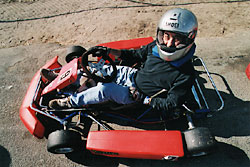
the combinations
of fast and slow corners, including very exciting banked ones were just right,
allowing drivers of all levels to have a great time. even though it was not
supposed to be a race, most drivers went at it with gusto which generated some
pretty intense racing. at the end of the main straight we were clocking almost
60 miles per hour, and sitting only 2 inches from the ground....
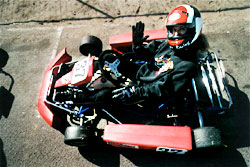
lunch was
provided in a covered area in the pits, and included filet mignon and caviar,
ok, ok, just kidding! it consisted of great sodas, chips and i think there were
also some sandwiches and a lot of cold water.
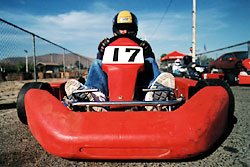
we wish to
thank kevork hazarian and craig ekberg for organizing the event and handling
the registrations.
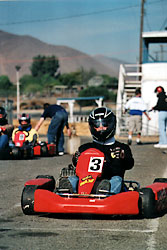
First Southwest Region Christmas Party Deemed a Success
article by tom brockmiller
photos by danny clark

in some ways,
it doesn?t feel good to hash over an old party from christmas, since it?s come
and gone. we had a great time. those of you who weren?t there will never know
except by the pictures. sabatino?s famous italian sausage restaurant in newport beach
catered
a fabulous dinner in the clubhouse overlooking the pool. taste buds flourished
and needed immediate extinguishing from the sicilian summer. the drink of
choice was the red grappa. i was wrong again thinking that most people still
like white. ah, the diversity of those americans. creatures of survival, they
switched mid-stream.
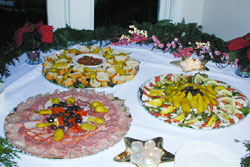
and then on
to the tent on the beach to watch the newport beach festival of lights boat
parade with heaters, fca cake, coffee and more of that left over white stuff. i
love being spoiled. i deserve. i could go on about how many wonderful celebrity
people there were but in truth we only had room for fifty celebrities.
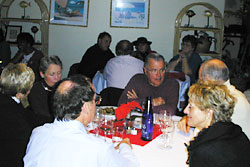
next year,
our 2nd annual marv landon?s christmas party, will be december 22nd, on the
beach, lido peninsula, with plenty of room for all and lots of red. marv,
thanks for a great evening.
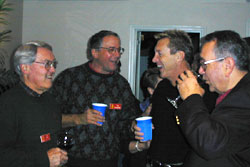
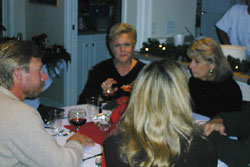
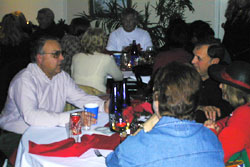
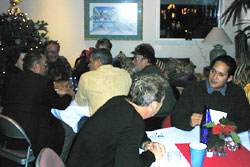
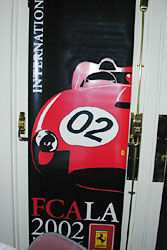
FCALA at California Speedway
by steve tillack
friday - sunday, may 24thth

southern california?s premier auto racing facility will be the exclusive domain of the ferrari
club of america during fcala 2002. the california speedway offers complete
state of the art hospitality accommodations for the racer and spectator
including "real" sparkling clean restrooms. when you arrive you will find a
spacious "no door ding" area dedicated for ferrari only parking.
spectators
will enjoy a panoramic view of the entire track from infield terrace and you
will be treated to a fine italian lunch, catered daily. in addition, a limited
number of the private suites will be available for rent. positioned at the
heart of california speedway atop pit row, terrace suites offer a comfortable
refuge just a few steps away from the action and excitement of the garage
area. the pit row terrace suites offer accommodations for 30 guests, an outdoor
roof-top viewing deck, closed-circuit tvs, public address system, telephone
service (local and credit card calls), air conditioning, and a wet bar. the
cost will be $1,500 for the event. for information regarding the rental of the
suites, please call marv landon at (818) 971-3300, extension 2350.
track event
participants will be running on the newly constructed 2.7 mile road course.
starting with a run up the oval?s 11 degree banked front straight to turn one,
the track transitions to the 21-turn infield. at the completion of the infield
road course, the track merges back onto the oval at the exit of turn four. as
expected, the paddock facility has exceptional accommodations for trailer
parking. in addition, a limited number garage spaces will be
available. california speedway has spotless and enormous infield garages. the
fully enclosed garages are roofed, walled and lockable with unlimited access to
electrical power inside and out. air is also available at each stall. each
stall will be available for $300 for all three-track days. they are on a first
come first serve basis. contact steve tillack for garage reservations at (310)
318-8760 or simply indicate you want a track garage on the event registration
package - form 1.
California Speedway History
courtesy california speedway

speed and
close racing aren?t necessarily the issues when fans and racers discuss the
california speedway. in its brief three-year history, the $120-million
state-of-the-art facility has made its mark in motorsports as a home to cart,
irl, nascar, the grand am road racing and the ama u.s. superbike series.
those in
attendance have not only been treated to great racing, but to some of the best
creature comforts known to exist. how many speedways can boast of a train
station, concierge services or hot showers? luxury suites offer breath-taking
views of not only the speedway and its manicured-grounds, but of the san gabriel mountains
and san bernardino valley. in its short existence, california speedway has
developed a reputation of offering the best for not only its fans but
competitors.
henry j.
kaiser and roger penske, are two men who have left their mark on history by
utilizing the same 529 acres in fontana, california. with kaiser, fontana
was recognized as the home of kaiser steel, the first
integrated steel mill west of the rockies. built during world war ii, just outside the
projected range of japanese battleships, the mill provided steel necessary for
the construction of liberty
ships. kaiser steel, at one point, was the economic
hub of the area, employing a work force of more than 11,000. but on dec. 31, 1983, kaiser
steel went bankrupt and closed forever.
the site was
abandoned and became an eyesore, rubble and rust dominating the landscape.
movie production replaced steel as the money product. that changed 10 years
later when kaiser ventures inc. and penske corporation exchanged thoughts about
a speedway. an agreement was reached in early 1995 and there were already
indications this project was about speed.
before
construction started, nascar and cart gave the track dates for the 1997 season.
san bernardino county
put the project on the fast track, effectively
eliminating bureaucratic roadblocks in the permit process. within months, the
transformation of blighted site to speedway was underway. more than 21,000 tons
of hazardous waste was removed and 370 tons of coal tar was recycled.
when kaiser
won the the governor?s award for environmental and economic leadership, the
speedway project had a green flag. on
nov. 22, 1995,
a work force that numbered in the thousands began demolition and construction
at the same time.
121 LM - 446 S - 735 S
ferrari market letter article reprinted with permission
purists will
argue that "real" ferraris have twelve cylinder engines. but more ferraris have
been built with v-8 engines than any other configuration. nearly every
ferrarist is at least aware of the fact that the v-6 layout was once quite
popular at maranello, in formula one, formula two, sports/racing, and
production types. those who have even a passing acquaintance with ferrari?s
history are aware of a period of flirtation with in-line four cylinder engines.
an in-line six cylinder ferrari? are you sure we are talking about the same
automobile company?
indeed we
are. faced with the challenge from mercedes benz, ferrari took the approach
that more of a good thing was even better and enlarged the in-line four
cylinder engines that had been successfully proven as far back as 1952? not by
increasing the bore and/or stroke dimensions, but by increasing the number of
cylinders. the four cylinder engines were developed originally to take
advantage of their superior low-speed torque, and had successfully won
ferrari?s first world championships in 1952 and 1953 with alberto ascari
winning the drivers world championship. capitalizing on this success, ferrari
put the in-line four into a sports racer in late 1953, and for 1954 continued
their development.
in 1954
mercedes benz was dominant in formula one, and when the german firm announced
that in 1955 they would contest the world championship of makes with a sports
car based on this f1 car, ferrari know that there was a formidable challenger
for the sports car championship it had won in 1953 and 1954.
the first
in-line six was the type 114, a three-liter engine with bore and stroke
dimensions of 90 x 78 mm, identical to the four cylinder 500 mondial engine.
while specification for this engine and a 2,480 mm wheelbase chassis were
published -- the car is usually referred to as the 306 s -- in late 1954, no evidence
appears that it was ever raced. next in the in-line six genealogy came the type
115, and experimental 2.5-liter formula one engine, and then the type 118,
which would be the first of the engines to see use in competition.
in simple
terms, the type 118 engine was a 625 four cylinder with two additional
cylinders. with a bore and stroke of 94 x 90 mm, this gave a total displacement
of approximately 3.7 liters. most commonly known by the engine type number,
hence 118 lm, this car also is the car that won europe?s most prestigious sports
car race, the 24 hours of le mans. the engine was dry sump with dual ignition
via two distributors and had, just like the four cylinder it was developed
from, dual overhead camshafts. depending upon the source consulted, it produced
280 to 310 horsepower. the chassis was quite similar to that of the 500
mondial/750 monza -- large diameter steel tubes with supplemental bracing by
smaller tubes, independent front suspension with coil springs, a rear-mounted
five-speed gearbox and rear suspension of de dion type with transverse leaf
spring -- but the wheelbase was enlarged to 2400 mm to accommodate the longer
engine. body work was by scaglietti, and again bore an extremely close
relationship to that of the in-line four cylinder cars.
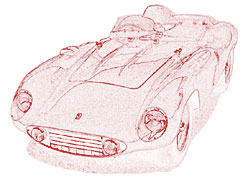
the first
appearance of the in-line six in competition was at the 1000 km. of buenos
aires on january 23, 1955, where a 118 lm was entered by the factory for
gonzalez/trintignant. it set the fastest race lap but dropped out while running
second due to fuel pump failure and an "unauthorized" shortcut into the pits.
on april 3, the type made its european debut at the tour of sicily, where
taruffi won in an 118 lm. next, on april 30 - may 1, came the mille miglia, and
the introduction of a new in-line six, the 121 lm or 446 s or 735 s, depending
on<









